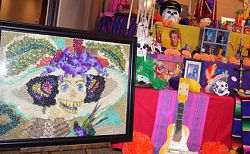Symbolism of Day of the Dead altars

The altars/ofrendas have several elements that are very important because they invite the spirits and welcome them on their journey.
Altar
The ofrenda is a tradition in Mexico. Depending on its size people can use a table, a shelf, or a whole room using elements such as boxes, chairs, bricks or hay.
The altar’s levels represent life periods.
•Two-level altars represent heaven and Earth.
•Three-level altars represent heaven, Purgatory and Earth. They can also represent heaven, Earth and the other world according to the Aztecs, or in the Catholic tradition, the Father, Son and Holy Spirit.
•Seven-level altars represents the seven levels that you have to reach to get to heaven.
Pictures
Usually a picture, painting or image of the person who is being honored is placed at the top of the altar.
The Cross
Every altar has symbolism that refers the cross; this element was added by the Spanish missionaries with the purpose of incorporating Catholicism. The cross usually is set next to the image of the dead person who is being honored. A small salt cross in the altar is meant to purify the spirits; an ash cross is set to help the spirits to get out of the Purgatory.
Arch
This is set in the highest part of the altar; it symbolizes the entrance to the world of the dead. It usually is decorated with yellow marigold, the symbol of death, also known as cempasuchil or zempasuchitl cempasuchil.
Cut Paper
This represents joy.
Candles
These are used as guides to this world. Four big candles are set, symbolizing the four cardinal points. Other candles are spread over the altar, representing the path for the dead to get to the earth.
Water
Water is very important and has several meanings. It reflects the purity of the souls. It can reflect the regeneration circle of life and death. Usually a glass with fresh water is set in the altar so the spirits can refresh themselves and continue they journey. Sometimes a bowl of water with soap and a towel are set in the altar so the dead can clean up.
Flowers
Flowers are use as decorations in every altar. Yellow mardigolds, also known as cempasuchil or zempasuchitl cempasuchil, are usually spread all over the altar, besides serving as decoration, their scent guides the spirits to this world.
Skeletons
This is a reminder that death is always present. The skeletons are very colorful and made of sugar, clay or chocolate, with colorful decorations .
Food
Days before the altar set up, people cook traditional dishes such as tamales so the dead can enjoy the smells.
Bread
This represents the generosity of the host and a gift from the earth.
Alcohol
Some altars have alcohol, sometimes presented as small jars with tequila, others with beer, usually with the drink that the dead person used to enjoy.
Personal objects
These are belongings of the dead person that are set in the altar so the spirit can remember moments of his/her life. If the dead person is a child, usually toys are displayed.
© Copyright 2024 The Diocese of Salt Lake City. All rights reserved.

Stay Connected With Us